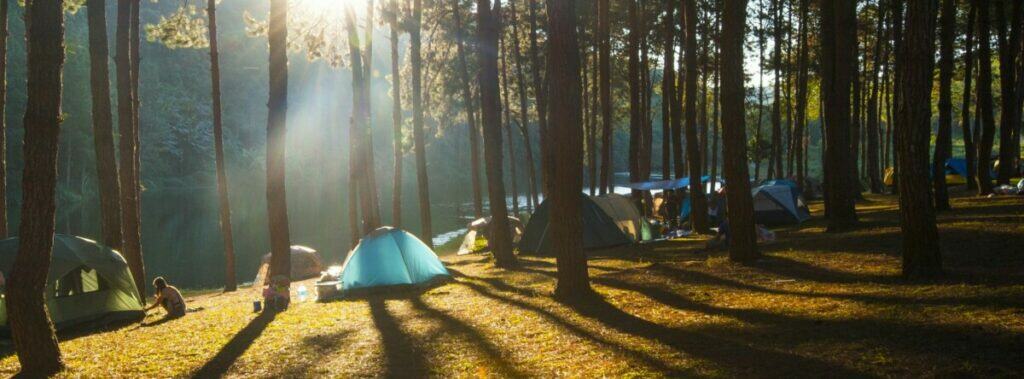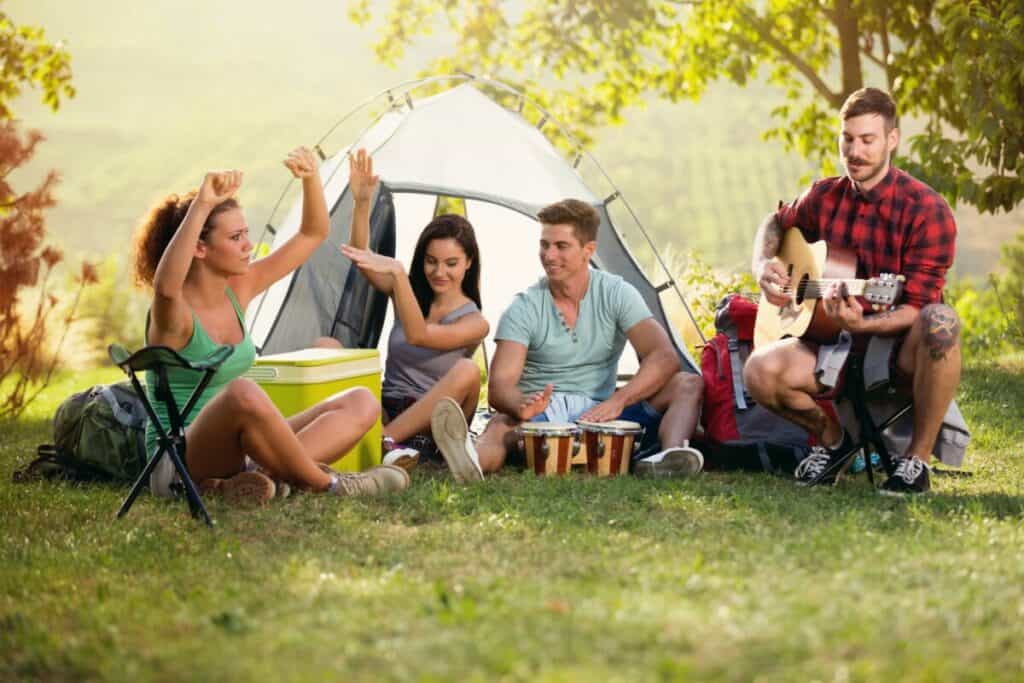
Many people enjoy summer camping, but being exposed to high temperatures all day and night can get unpleasant, especially in a tent. So, what can you do to keep cool in a tent?
To stay cool in a tent, wear light, breathable clothing, use linen sheets with a low R value sleeping pad, stay hydrated and bring a portable fan. Keep the tent cool by pitching it in the shade and opening the tent doors and windows.
There are several ways to keep cool in a tent and sleep comfortably through the night. To learn about these options, keep reading.
How to Stay Cool in a Tent
One thing you can do to stay cool while in a tent is wear lightweight clothing. Your sleepwear should be a light and loose natural fabric like cotton. I remember how effective a cotton sheet was as a blanket during those extra hot Michigan nights, camping as a kid. Linen clothing and sheets work even better.
Also, try a portable fan. There are many fans that can be hung in tents and blow air directly down on you while you sleep. For the daytime, you may be tempted to purchase a neck fan. The cheap ones will only help if you are (well hydrated and) sweaty. There are neck fans with cooling plates, but those can be quite expensive.
If fans simply don’t cut it, why not a portable air conditioner? Unfortunately, the portable air conditioners that run on batteries aren’t a great option. They are often unreliable fans that simply spray mist. Moisture can be dangerous if temps drop overnight. The effective AC units require an electrical hook up or a gas generator. A generator and an AC unit is a lot to haul on a tent camping trip. Also, you would need to seal the tent somehow to actually keep the tent cool. You would be better off choosing a cooler month, cooler destination or simply staying at a hotel instead.
Hydration is needed to produce sweat, your natural defense against overheating. You may want to hydrate well before sleep time (e.g. before 7pm), to avoid those less than pleasant midnight bathroom trips in the woods. Avoid alcohol if nighttime cooling is a priority.
One thing that works like sweat to keep you cool is a cooling towel or wet bandana. Put the cooling towel or wet bandana around your neck prior to going to sleep. Make sure the towel is saturated with water, but not dripping. My parents love their cooling towels, even when they aren’t camping. An even nicer option, if available, is a nice swim of course.
If you happen to have extra cooler space or extra ice, an ice pack under a pillow might help, even if it’s just to cool down prior to falling asleep. Sleeping with an ice pack is probably not a good idea, especially if there is risk of leakage. In a similar way, a cooling pillow from home may give you some temporary relief, at least enough to fall asleep.
Don’t use a sleeping bag or thick blankets while in a tent, but you do always want those available in case temperatures drop during the night. As mentioned above, a top sheet is a good summer blanket alternative. I typically use bottom sheets on air pads instead of sleeping on top of my sleeping bag.
Sleeping pads have R values that indicate how much insulation they offer. Purchase a summer sleeping pad with a low R value (e.g. 1 or 2) to allow more heat to escape through the ground. Again, make sure you are aware of the forecast any nighttime temperature drops, as these can be extreme in deserts and high elevations.
Finally, evening meals should be avoided prior to bed if your goal is to feel cooler in the night. Eating can raise your body temperature via thermogenesis.
How to Keep Your Tent Cool
Adding a fan or an air conditioner can reduce the temperature in your tent, but there are a few things you can do to help prevent the tent from getting too hot in the first place. Adding shade will reduce the heating effect of direct sunlight. Maximizing ventilation will allow any extra heat trapped inside the tent to escape as well as cool anyone inside the tent.
The tent rainfly can significantly reduce ventilation. If the weather is good, keeping a rainfly off can help that air moving. Just remember to put the rainfly back on if there is any chance of rain, especially when leaving camp.
To keep your tent cool, pitch it in a shady area. Trees will keep the sun off your tent, keeping it cool. Just be careful of widow makers, dead branches or trees that could fall on your tent. Placing a tarp over your tent could also provide shade. However, you will probably need trees anyway to hang a tarp high enough to allow for full ventilation around your tent.

If you don’t have a tarp, but you do have an insulated blanket, you can use that instead. If the blanket has an aluminum side and a normal side, make sure the aluminum side faces up, or else it will keep heat in your tent rather than keep it out. Shade cloth (e.g. Aluminet) is another option in windy and dry areas.
When you purchase a tent, make sure it has good ventilation. To keep your tent cool, open the doors so the mesh is still in place, but the nylon material is not. The mesh will allow air and wind to flow through the tent, keeping it cool, but preventing bugs from getting in.
Also, if you are car camping (vs. backpacking), purchase a tall rather than a short tent, as it will give the air room to circulate and allow the hot air to rise above you. In a stand up tent, the temperature at the ceiling may be almost 20 degrees Fahrenheit hotter than the temperature at the floor. If you have a low tent, you won’t be able to avoid the hottest part of the tent, the ceiling. If your tent is tall, you can sit below the hottest air.
Why Do Tents Get So Hot During the Day?
Tents get extremely hot during the day during the summer season because even though tents are usually made out of lightweight materials, they trap air in them. Air flows in well, but doesn’t flow out, even if you leave the doors or mesh panels open. During the day, that air and the fabric heat up, making the tent extremely warm.
However, you can avoid this or help prevent this by doing some of the things previously mentioned. Shade and good air flow are important when weather is sunny and hot. My family and I are either doing water sports or hanging out under an open-air pop-up canopy during the hottest time of day. We also try to get to bed early and get up with the sun to avoid the summer challenges of early sunlight, heat and loud birds while tent camping.
Best Fan to Use in a Tent

A portable a fan can be an inexpensive and highly effective way to keep cool in your tent, day or night. Some come with lighting as well and can be hung from the ceiling of your tent at night. The fan below is my recommended option, but there are countless to choose from on Amazon.
CONBOLA Portable Battery Operated Fan with LED Lantern
The CONBOLA Portable Battery Operated Fan with LED Lantern costs $36 and is rated 4.5 out of 5 stars. It is powered by a rechargeable battery and comes with a Type-C fast charging cable and takes about 5 hours to recharge. It has a hook so you can easily put it almost anywhere in your tent to help keep you cool.
This fan lasts for 8-36 hours on a single charge, enabling you to use it for the entire day to keep your tent cool before you get in it. It has LED lights built-in with 3 settings, which can come in handy as a nightlight if you have kids.
It is a small and highly portable product. You may want to consider buying more than one if you are camping with your family. I would put one at the ceiling of the tent and another blowing more directly across the kids.
